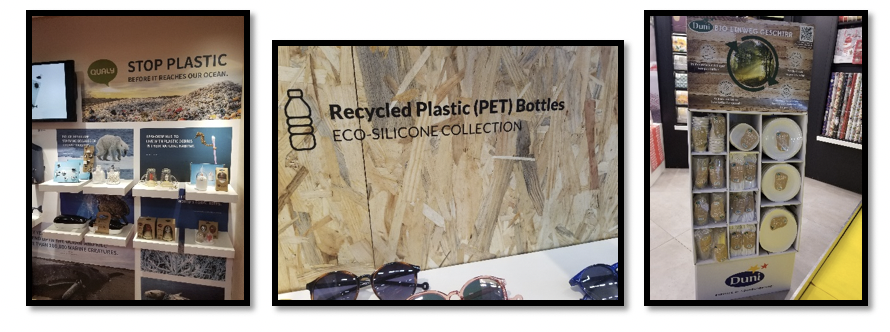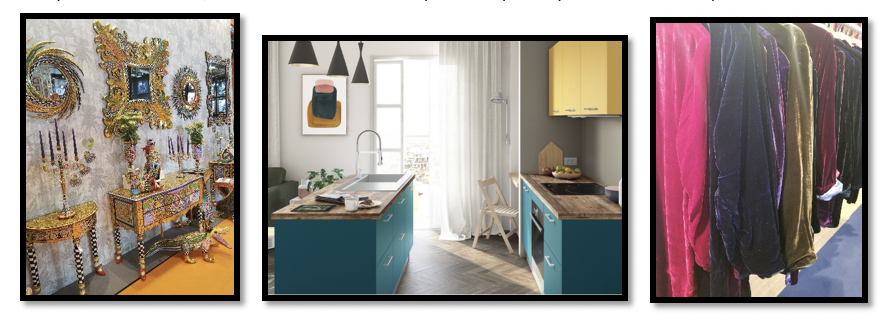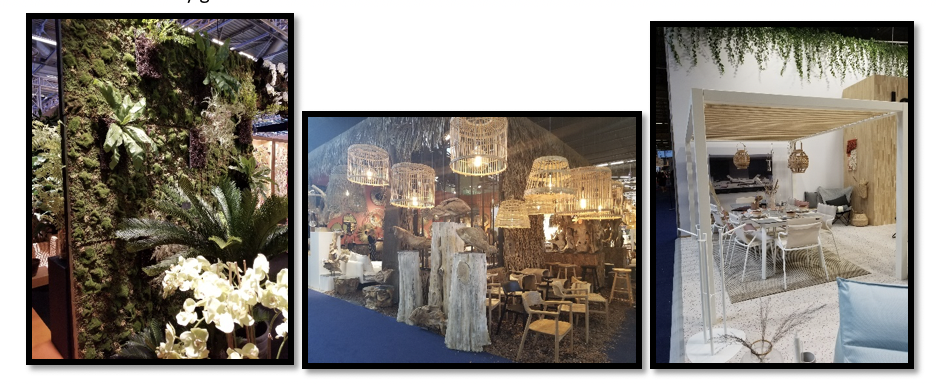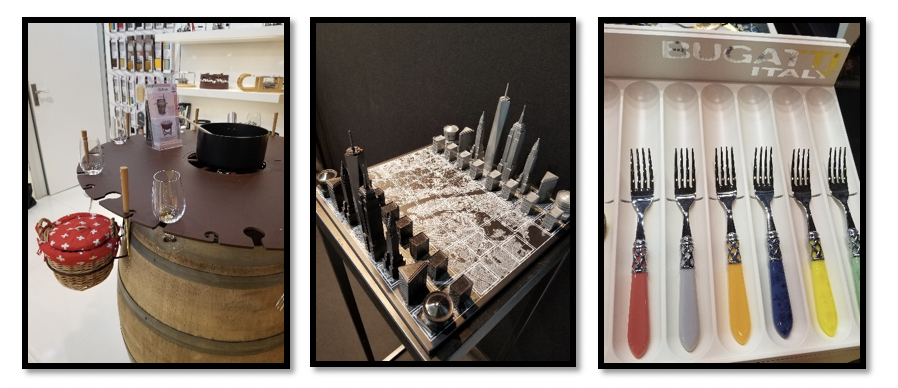Maria Stapperfenne, CMKBD, CLIPP, designer for Tewksbury Kitchens & Baths in Oldwick, N.J., and a former NKBA Board President, shared a story she wrote for Seasonal Living, reporting on five key trends she discovered at the Maison et Objet show.
Maison & Objet 2019, Paris, France
Five Top Trends:
- RETRO — Going back. Cookware is back to all metal, all the senses are engaged by bold colors for the eyes, Bluetooth connectivity for your listening pleasure but presenting itself in an old-style radio or turntable. Your phone’s screen has a stand/magnifier that resembles a small vintage style tube TV. Beautiful flowing linen fabrics offer a soft feel on the skin, and candles to enhance the scent of the environment with lovely florals and woodsy scents with delicious combinations and blends. Rattan outmoded? A stylistic throwback to the Seventies? Not at all! This is showing up to date through collaborations with adventuresome young designers. More bespoke and luxe Items are bringing the “hand” back into “hand-designed,” and period items that were both opulent and comfortable were all prevalent, suggesting the “Good Old Days.” Maison put out an email with the suggestion that this was, “Back to the Eighties,” and while some of this was true, I saw several earlier time periods referenced. I guess it’s whatever the “good old days” are for you. Historically, this retro-styled trend appears when society is afraid of what the future may hold…people look for the comfort of those “good old days.”

- SUSTAINABILITY — Many manufacturers couldn’t wait for the opportunity to promote that they’re using recycled materials or processes in their products. Environmental consciousness appears to be the new normal in promoting new products. Items were shown that included the reuse of cork, plastics, juice pouches, bicycle and car tires, pull-tabs from cans and building products that include shutters, windows and doors. At first, it seemed like plastic was the enemy…unless you were using it to make something else! There were vendors touting the benefits of glass and metal straws, a set of reusable chopsticks that slides into a spoon and cleverly designed containers to bring your meals and needed accessories anywhere. Gorgeous wall panels were created from salvaged wood and tree roots. A whole floor space section was dedicated to shopping bags of all sizes and shapes, with and without wheels — because they are a huge market in Europe. Living in a metropolitan area, many places don’t have disposable bags, and walking, biking or public transportation are commonly used.

- COLOR/TEXTURE … and LOTS of it! The French have been very into teal for quite some time and this hasn’t gone out, but what has changed is what it’s paired with. This year it is teal paired with mustard! The “in” fabric this year? Velvet! This was everywhere on the show floor, in furnishings, clothing, gifts, decor and even in kitchens. Lapeyre, a more moderate showroom, surprised me with all the luxe, color and affordability of kitchens here. For as much as natural items were very in vogue throughout the show, splashes of color were considered carefree, fun and youthfully on-trend. In fashion, it was interesting to see that only English/American words were printed on garments, and these phrases either didn’t make sense or were curse words flaunted by the unknowing victim/wearer. I saw the F-bomb used on reusable water bottles, lunch totes, stationary, gifts, rotating signs, plaques, and other accessories…I must admit, no matter how many times I saw this, and sometimes it was hysterically funny, it was still unexpected.

- ORGANIC — Indoor items attempted to look like outdoor items: fabrics, lighting, furniture and shades. There were many booths showing the living wall scene in either natural or artificial plant life — anything to bring the outdoors to indoor living environments. Outdoor furniture to decorate your space all the way to the property lines was beautifully shown and promoted on the show floor. The style of work environments also showed this trend moving away from the playful foosball table and other games everywhere (even though some were still there) to more of a “zen and wellness” office environment, which also included office balls for seating, a treadmill at a working desk, and pods for quiet. This has become important as Millennials continue to work collaboratively, and sometimes need a quiet space to take a conference call, have a private meeting or just wind down. These are clear, so one is still visible, just in a sound-isolating space. (In the past, we called these phone booths!) In the Kids Hall, there were notable shifts to older-styled toys made of metal, wood and (renewable, of course) cotton. There was a notable brand exception: The TY booth that had dancers breakdancing and moving to American music, rivaling the Kohler booth fly girls at KBIS!

- FUNCTIONAL ART — Artisanal sophistication – weaving, pottery and glasswork are again bringing the “hand” back into “hand-designed.” Not only did we see an artist who used can tabs to make purses and jewelry, but it was all about the design and crocheting done artistically between the tabs. This is something we mentioned earlier, but it is all about beautiful, elegant craftsmanship for the luxe market with hand-painted table and flatware. Some are from famous, well-known and respected design houses. One artist used crushed pearls in her paints and makes each swirl with her fingerprint. Another artist makes chess sets where the pieces represent iconic buildings and architecture from cities around the globe, like New York, Dubai, Paris, London, etc. Very cute, small colorful dragonfly and animal bookmarks were 3-D printed. Crystal, along with brushed, satin or polished gold are defining luxe products, including tableware, lighting, cabinet hardware and accessories. Paired with velvet from the fabric trends, these items typified most high-style design spaces.

During Design Week, it was interesting to attend a talk on design where is was clearly stated that French designers on the panel feel the American design world got stuck in the 1950’s. After this mid-century modern, there has really been no global design trend coming from the U.S. Perhaps because this period was the last time America had a design trend that went worldwide. Also, the lack of local manufacturers is limiting the growth. Design studios take notice of who the customer is — they point out that in the U.S., it’s the interior designer who makes the purchase…not the ultimate end client. Why? Because today’s Americans haven’t grown up with “design” in their daily culture, so it’s more foreign to them, and they are afraid to risk the expense of a bad design decision. Most lack the confidence to make their own design decisions, and instead engage an interior designer. The good news? Designers do feel the U.S. market is much more accepting, collaborative, and very open to the new designer. In France, designers hear “no” a lot, while in the U.S., they are more apt to hear a “yes” or “sure, why not?”
Wanted Design, a Brooklyn, N.Y.-based firm, feels they are a family and bring a community approach to design. They are one of the few platforms to highlight American designers. Designer-run collaborative shows are supporting this growth because they have a lower entry cost, and are therefore more accessible. A lower entry cost offers flexibility, allowing the designer to create more of what they want to create, but a high-cost show entry would require a return on investment, necessitating that items sell at a much higher price. This wouldn’t necessarily be what the artist wants to create, but what will sell/pay the rent. “Launchpad” is one show that currently does this.








